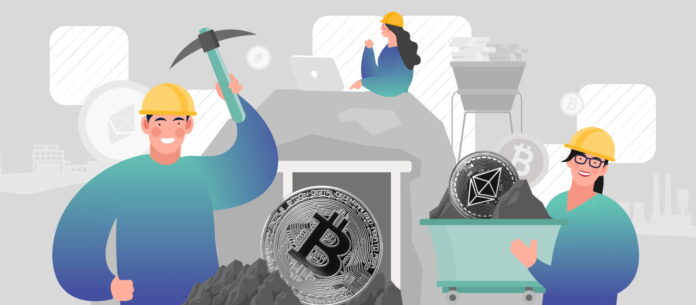What Is Liquidity Mining and its different Types? Yield farming, also known as liquidity mining, is a creative way to use bitcoins by supplying liquidity to decentralized exchanges. But what is liquidity mining, and how does it benefit consumers, platforms, and the market as a whole?
A segment of the current population, including newcomers, has yet to benefit from the DeFi gold rush and is ignorant of the advantages. As a result, people frequently inquire about what liquidity mining entails and why it is so important.
After all, the new incentive distribution method boosted the value of the decentralized financial market by tenfold in just four months. We’ve opted to explain this not-so-complex idea to give a straightforward overview and help you understand why liquidity mining has acquired such popularity. Interested?
Liquidity mining explained
Liquidity mining, also known as yield farming, provides liquidity to decentralized exchanges using cryptocurrency (DEXs). DEXs attempt to reward users that contribute capital to their platform, as this is the core goal of a conversation.
The majority of DEXs are decentralized by using an Automatic Market Maker to replace order books (AMM). A smart contract that regulates trading is known as an AMM. Users do not have to trade the order book of exchange because smart contracts are decentralized. Instead, they successfully deal with other users.
These platforms offered token switching for trading. It is possible to trade one token for another within a liquidity pool using token swaps. A user will be charged a fee each time he deals. On Uniswap, for example, that price is 0.3 percent.
As a reward, the AMM collects these fees and distributes them to each liquidity provider (LP). As a result, the DEX provides a symbiotic ecology where each group of users aids the other. While the token swapper pays a small fee to trade on a decentralized exchange, the liquidity provider is compensated for supplying the liquidity required by the first user.
The most crucial thing to remember is that each liquidity pool comprises two tokens, one for each trading pair. Most DEXs require a 1:1 pool ratio. This means that the liquidity pool must have an equal number of both tokens. This is accomplished by requiring LPs to contribute both assets and liabilities to the pool.
Incentivizing LPs further with governance
Decentralization is not simply a buzzword to throw about. Developers must turn a DEX into a community-owned initiative to ensure complete decentralization. The community, or the project’s “operators,” must be able to control the platform. So, how do programmers accomplish such a feat?
The majority of decentralized exchanges provide a governance mechanism in which users may vote to participate. The system includes a governance token that must be possessed to vote. To guarantee complete decentralization, most developers will divide the bitcoin equitably.
The token would be listed on the market, allowing interested parties to invest in the platform using the pass. In other situations, before launching the token, developers would distribute a part of the tokens to early community members.
Governance tokens are necessary for liquidity mining since they are frequently used as a secondary type of reward. Many protocols have chosen to reward LPs with standard yield rates while also including governance tokens in the mix. Liquidity mining became even more attractive as LPs gained a new source of revenue.
Furthermore, by participating in governance, individuals get a stake in the protocol. They may alter the protocol, how it operates and even introduce new liquidity pools due to this.
Categorizing liquidity mining protocols
Protocols for liquidity mining exist in many forms and sizes. Each protocol is separate and has its own set of features and reward distribution options. Nonetheless, the majority of procedures may be divided into three different types.
Fair decentralization:
Active community members are frequently rewarded in acceptable decentralization-styled liquidity mining programs. The majority of the time, governance tokens are issued to all of the platform’s early users. Developers maintain decentralization by giving tickets without holding a token sale or listing on a stock exchange.
Progressive decentralization:
These protocols are reticent to pass over platform authority to the community right once. Developers often develop a governance model months after the platform is first launched. Similarly, before developers put governance online, the token is sometimes listed on the market. The primary objective is to guarantee that token distribution is fair to prevent whales from amassing large governance tokens.
Marketing-oriented:
Marketing-oriented protocols are a sort of liquidity mining protocol that focuses on creating a lot of buzzes. Users are typically motivated to promote the platform before it launches, and the project is often exposed weeks before it launches. Developers may thus reach a large user base before the platform goes live. Platform marketing may assist in collecting cash for liquidity, which developers sometimes lock for lengthy periods.
Conclusion
Liquidity mining is a straightforward idea, as we got the opportunity to explain in this post. New decentralized exchanges can only succeed if they have adequate liquidity, which they must have to enable trading. DEXs incentivize cryptocurrency holders to contribute money by rewarding them with trading fees on the platform.
With the introduction of governance frameworks, developers made another significant stride with liquidity mining and decentralized exchanges. Users can post governance suggestions and vote on new changes using governance as a secondary incentive for active players who offer liquidity. Platforms issue a governance token, which is required to vote.
With the aid of liquidity mining, decentralized finance has grown by more than tenfold this year. As long as investors are engaged in liquidity mining, this exponential rise may continue. Liquidity has effectively moved from centralized to decentralized exchanges in 2020, perhaps ushering in a new era in cryptocurrency markets.


